Unboxing: MSI MPG A1250GS PCIe 5 – 1250-Watt Power Supply for Demanding Builds
- Foreword: A Package That Carries Promises
- Packaging Design & First Impressions
- Unboxing: Protection, Order, and First Touch
- The Chassis in Detail
- Cables & Accessories: Tools for Clean Cable Management
- Build Quality & Design Language
- Documentation & User Guidance
- Small Details That Stand Out
- What the Unboxing Reveals – and What It Doesn’t
- Practical Thoughts (Without Testing)
- Quality Impressions – Reading Between the Lines
- Unboxing Images: A Visual Confirmation
- Context: Why 1250 W?
- Safety & Standards – As the Box States
- Noise & Cooling – Only From What’s Visible
- Who This PSU Targets (From an Unboxing Perspective)
- Pre-Mount Checklist
- Quotes That Fit the Moment
- No verdict yet.
Foreword: A Package That Carries Promises
After the arrival of the – admittedly – hefty package, the box of the MSI MPG A1250GS PCIe 5 lay on the table. Still sealed, but already carrying the aura of a product destined to find its place in ambitious systems: 1250 W of power, modular design, modern connectors – and on the front, badges that speak their own language in the PSU world. “The details are not the details. They make the design,” Charles Eames once said – and it is exactly these details we’ll focus on in this unboxing.
Important: This is strictly an unboxing. No performance testing, no noise measurements, no software evaluation, and no conclusion yet. We stay with haptics, optics, included accessories, labeling, and what can be inferred from the packaging and enclosed materials.
Packaging Design & First Impressions
Front Side: Certifications, Logos, and Clear Messages
The front side is typical MSI Performance Gaming (MPG): a dark background, angled lines, a large product photo of the PSU with its strikingly diagonal fan grill. On the top left, the MSI dragon logo sits prominently, while the top right displays several badges:
- CYBENETICS ATX 3.1 – PASS
- ATX 3 – PASS (as a separate badge)
- PPLP.info seal (Gold)
- 80 PLUS GOLD
- “READY FOR AI PC” as a design accent
Alongside in large letters: MPG A1250GS PCIe5, with 1250 Watt Power Supply noted beneath. The front communicates without hesitation: This is a strong, modern PSU capable of handling current-generation graphics card standards. “Form follows function” – the famous design principle – fits perfectly here: the marketing is loud but substantively focused.
Note: MSI emphasizes ATX-3.x-generation compatibility and PCIe 5.x graphics cards right on the front. For an unboxing, that doesn’t mean performance data yet, but it does show the direction – especially regarding the latest 12V-2×6 connectors (16-pin).
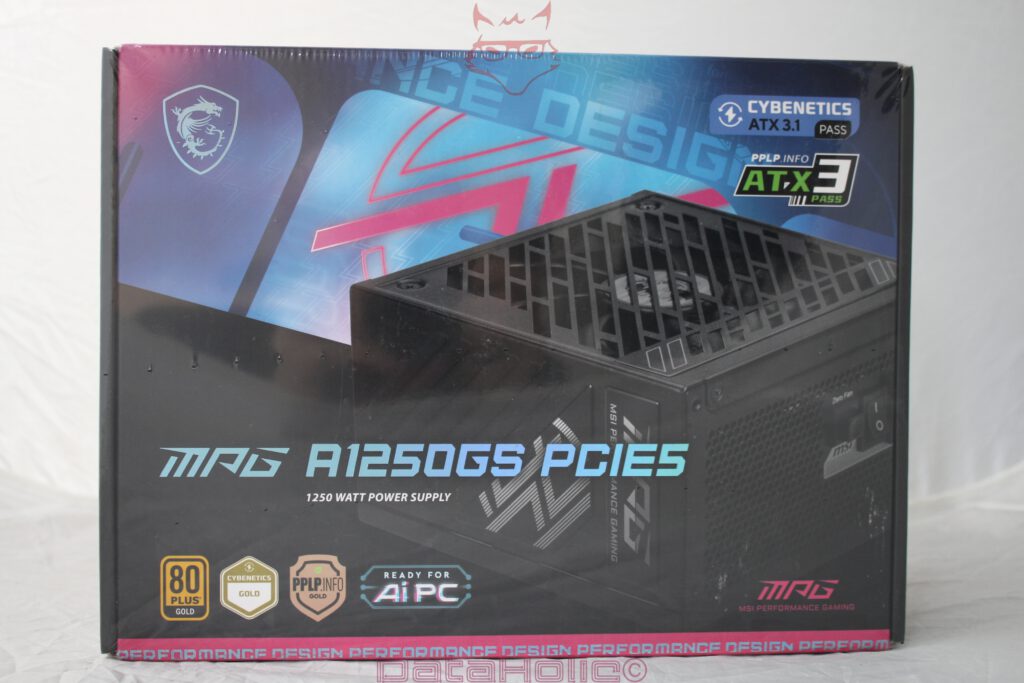
Back Side: Technical Diagrams, Cable Lengths, and Specifications
The back of the packaging is the real information hub. Here we find three large content segments:
- Feature Highlights with Short Texts
- Dual native 16-pin connector – MSI explicitly mentions two “native 12V-2×6 connectors” (i.e., 16-pin GPU cables) for modern graphics cards and workloads (including AI computing).
- Optimized sound level – combined with efficient cooling design, the fan is meant to remain whisper-quiet under low load while providing sufficient airflow under stress.
- 100% Japanese 105 °C capacitors – server-grade components promising stability and reliability, especially under sustained high load.
- Drawings and Cable Lengths
On the right side are schematic drawings of the main cables with their lengths clearly labeled. Among them:- ATX cable: 600 mm
- EPS cable: 750 mm
- 12V-2×6 (16-pin, GPU): 600 mm
- PCIe 6+2 cables: 600 mm
- SATA strands: 500 mm to the first connector, followed by 150 mm spacing
- Peripheral/Molex strands: 500 mm to the first connector, then 150 mm spacing
- Specifications & Connector Matrix
At the bottom, technical specifications are listed, including AC Input (100–240 V, 50–60 Hz, 15 A) and the DC rails. Key figures:- +3.3 V: 22.0 A
- +5 V: 22.0 A
- +12 V: 104.1 A (≈1249 W on the 12-V rail)
- −12 V: 0.3 A (3.6 W)
- +5VSB: 3.0 A (15 W)
- Total output: 1250 W
- ATX (20+4): 1
- EPS (4+4): 2
- PCIe 5.1 / 12V-2×6 (16-pin): 2
- PCIe (6+2): multiple (typically 6)
- SATA: 8
- Peripheral/Molex: 4
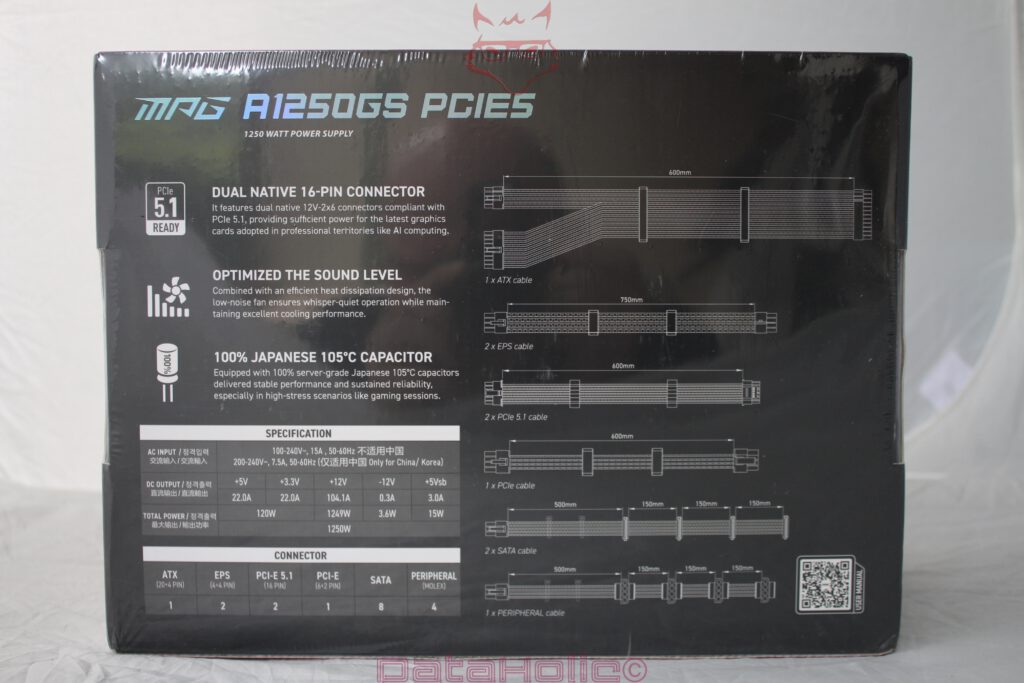
Unboxing: Protection, Order, and First Touch
Seal and Interior
After cutting the shrink wrap, the colorful marketing fades away, replaced by pragmatic order: The PSU rests snugly inside protective foam. The modular cables are bagged separately, with screws and a user manual (often provided as a QR code) tucked neatly away. The first impression: well-organized.
“Trust, but verify” – a phrase popularized by Ronald Reagan (originally a Russian proverb) – suits this look at packaging: solid shock protection, individually wrapped components, and clear separation of PSU and cables minimize transit damage. For a component delivering 1250 W, this level of protection is more than a formality.
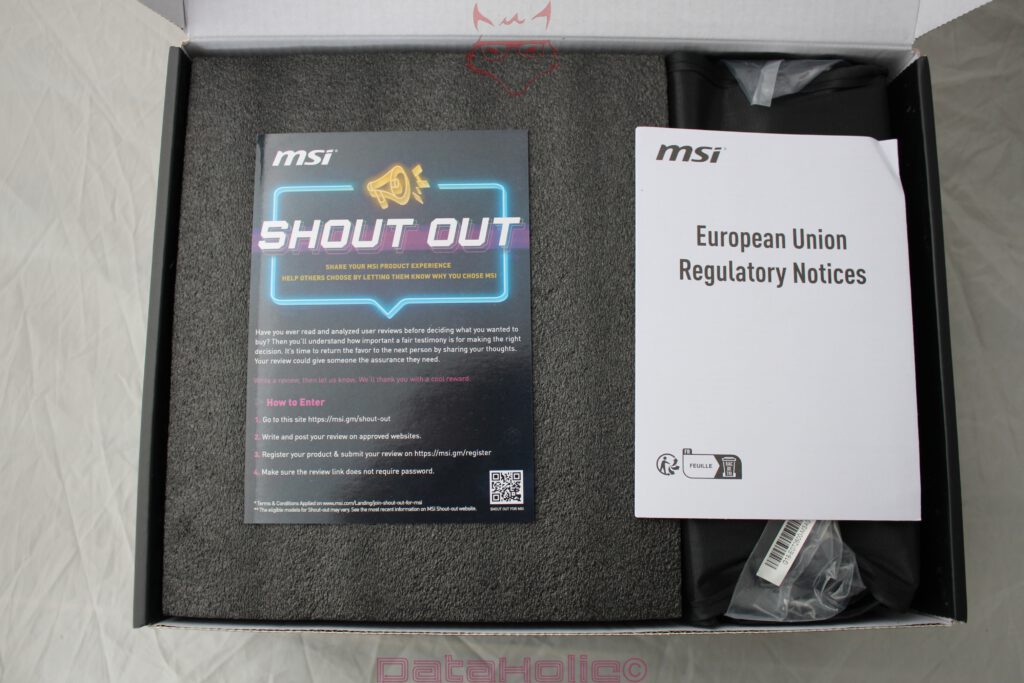
The Star of the Box: The PSU Itself
In hand, the A1250GS PCIe 5 immediately conveys substance: textured coating, clean edges, flush screws. The design is modern-industrial – flattened diagonals echo MSI’s design language. The sides are accented with MPG panels and the dragon emblem; it’s restrained enough to blend into minimalist builds but distinctive enough to stand out in showcase cases.
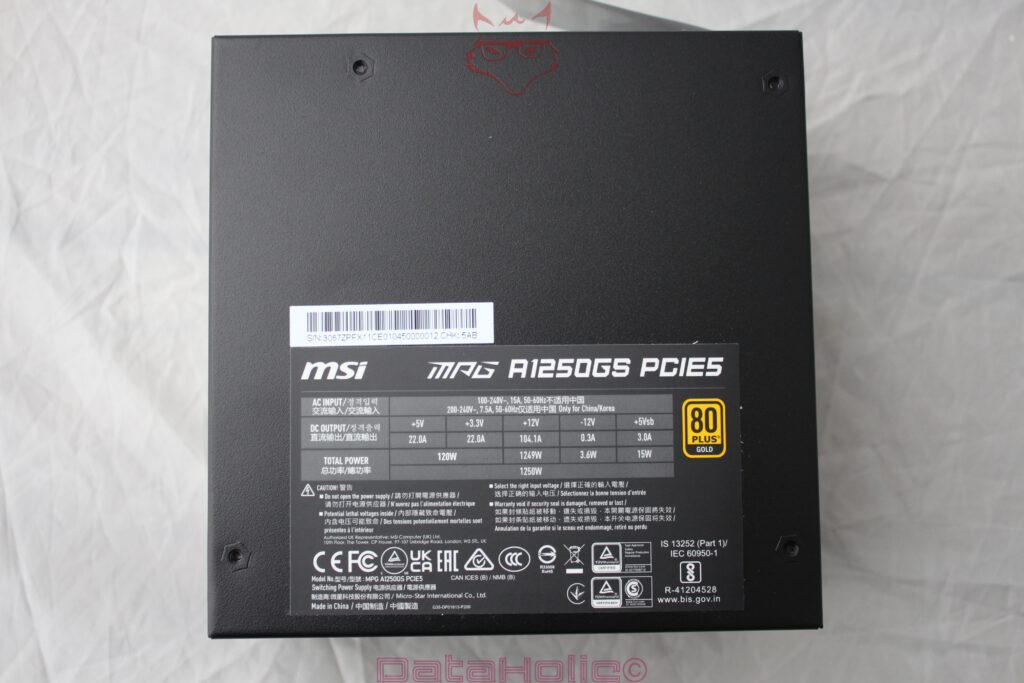
The Chassis in Detail
Fan Side: Diagonal Grill & Interior View
The fan side features a diagonally patterned grill. Through the openings, the fan rotor and some internal components are visible. A subtle MPG logo adorns one corner. The grill looks sturdy yet airflow-friendly – important, since restricted intake often causes unwanted noise. Here, airflow seems prioritized.
A “Zero Fan” sticker explains that the fan stops entirely under low loads. Common in modern high-efficiency PSUs, but not always guaranteed at this power level.
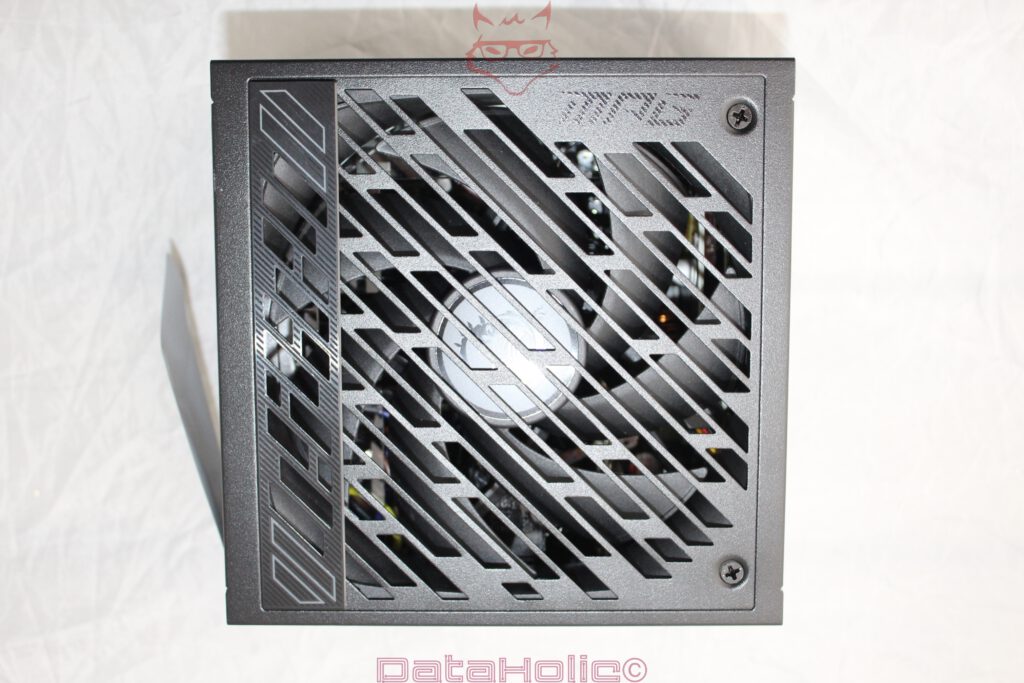
Modular Side: Clearly Labeled Ports
The modular rear panel is excellently laid out:
- Two 12V-2×6 ports (for 16-pin GPU cables), typically on the left
- CPU/PCIe ports in the middle
- SATA/Peripheral ports on the right
- ATX-24 pin at the bottom
The white labeling is crisp and readable. In practice, this makes cabling far easier: GPU left, motherboard (ATX/EPS) central, drives right. Logical and efficient.
Note: MSI labels the 16-pin ports as “12V-2×6”, which is reassuring. This is the updated standard, designed to be safer and more robust than the earlier 12VHPWR variant. For an unboxing, this signals modern compatibility.
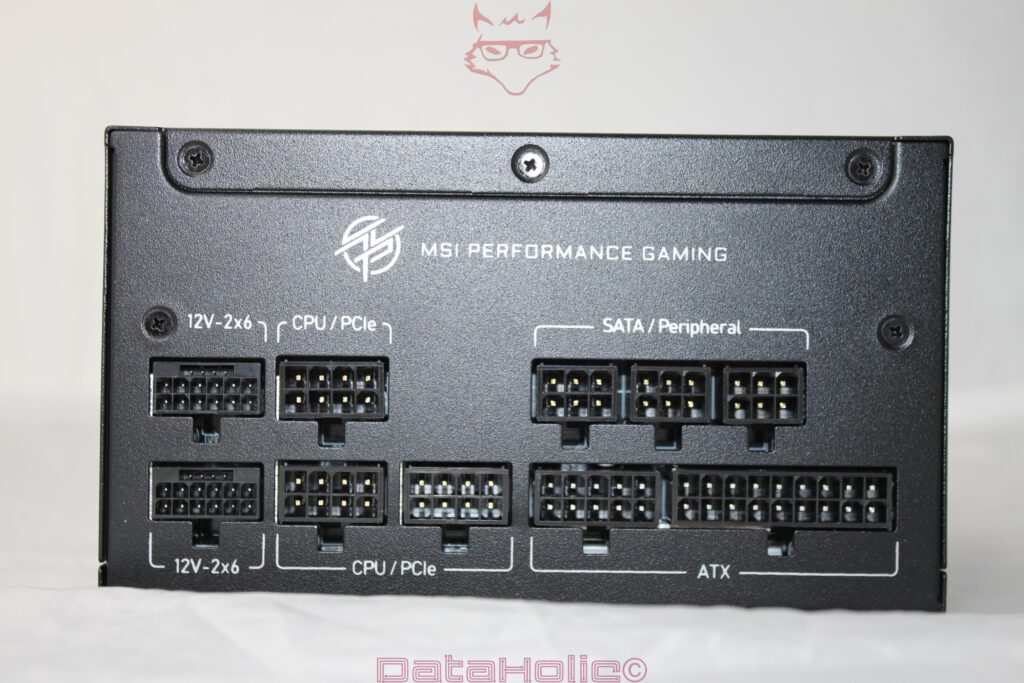
Side Panels: MSI Aesthetics Without RGB
The sides showcase textured reliefs with MSI lettering and the dragon emblem in a window-like cutout. There is no RGB lighting here – and honestly, it’s rarely missed on a PSU. The design remains professional and industrial.
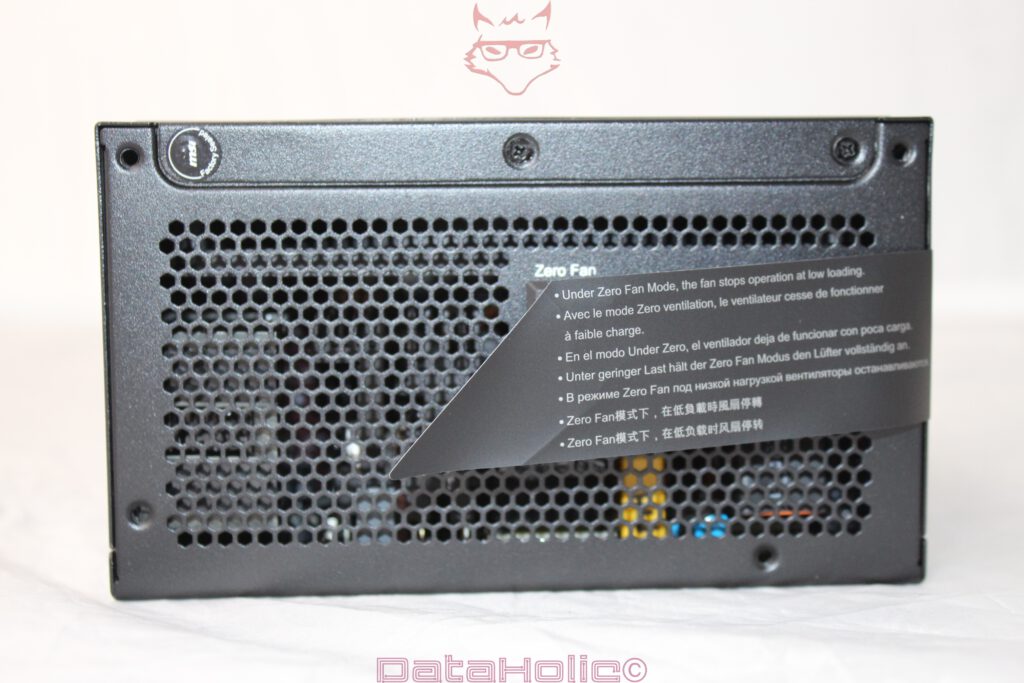
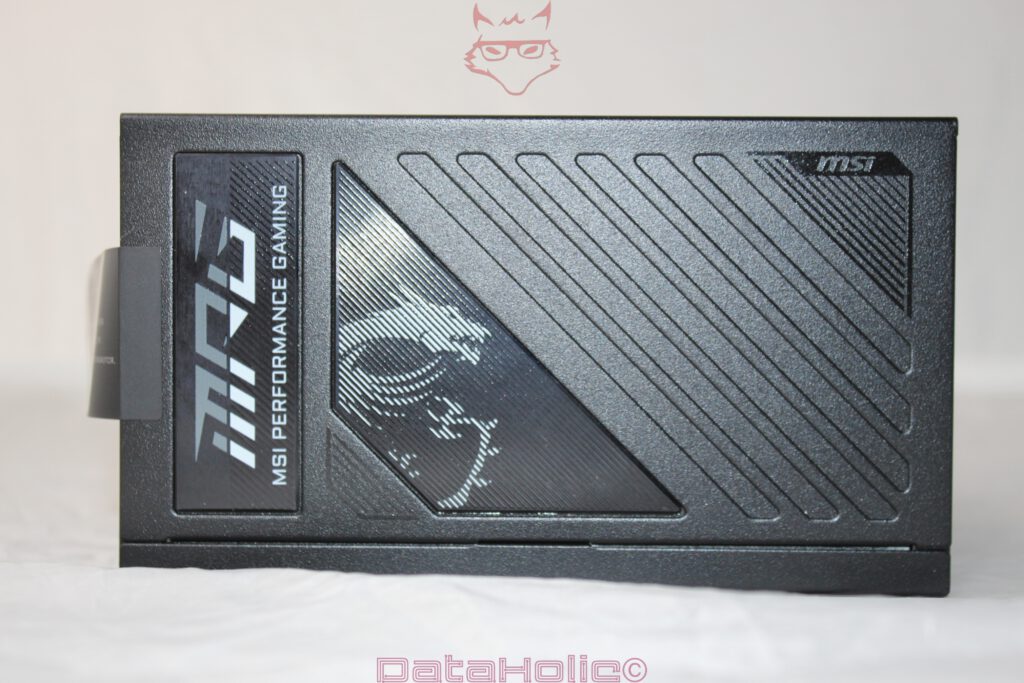
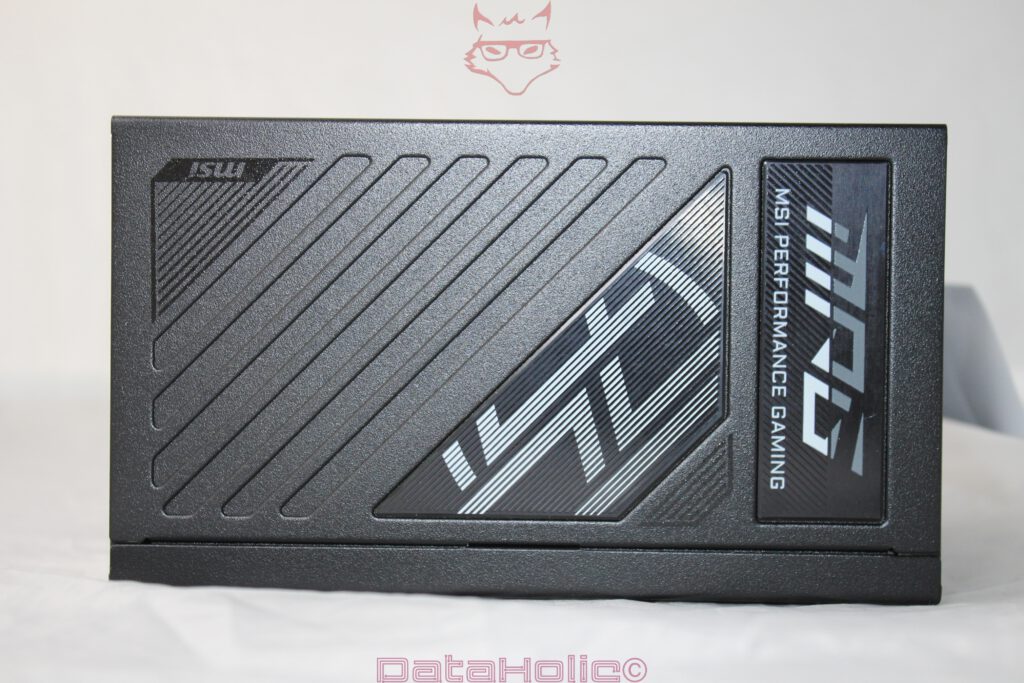
Underside: Data-Rich Label
On the bottom is the specification label listing key stats:
- AC INPUT: 100–240 V, 15 A, 50–60 Hz
- DC OUTPUT: +3.3 V 22.0 A, +5 V 22.0 A, +12 V 104.1 A, −12 V 0.3 A, +5VSB 3.0 A
- Total Power: 1250 W
Certifications (CE, FCC, UKCA, etc.) are present, along with the 80 PLUS GOLD logo. For an unboxing, this confirms the device matches packaging claims.
Cables & Accessories: Tools for Clean Cable Management
Full Set at a Glance
Inside, we find numerous black, flat ribbon-style cables. This is practical: they route neatly and look tidier than multi-colored round cables. The bundle includes:
- 1× ATX 24-pin (600 mm)
- 2× EPS 4+4-pin (750 mm) for CPU power
- 2× 12V-2×6 (16-pin) GPU cables (600 mm)
- Multiple PCIe 6+2 cables (600 mm)
- SATA cables (500 mm to first connector, then 150 mm spacing)
- Peripheral/Molex cables (500 mm + 150 mm spacing)
- Power cord
- Screw set for mounting
The printed box specs match the contents (8× SATA, 4× Molex, several PCIe 6+2). For storage-heavy or RGB-heavy systems, this matters.
Note: Both 16-pin GPU cables are native, not adapters. In 2025, this is a key quality mark. Antoine de Saint-Exupéry once said: “Perfection is achieved, not when there is nothing more to add, but when there is nothing left to take away.” Fewer adapters, more native connections – exactly this philosophy.
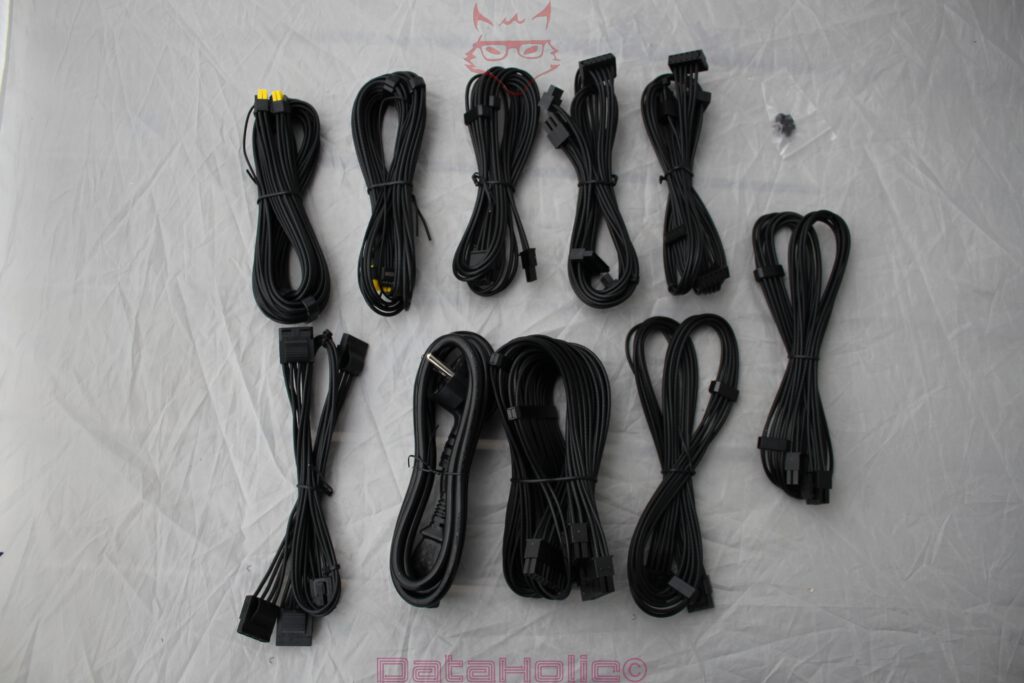
Haptics & Connector Quality
The cables are flexible but firm – easy to bend around tight corners yet structured enough to hold shape. Connectors snap securely; pins are aligned, sleeving at transitions is reinforced. The 16-pin connectors inspire confidence, crucial since they carry massive loads.
Editorial note: As always, avoid tight bends directly at the 16-pin GPU connector. Keep the first centimeters straight before routing sideways. This is general practice for safety.
Cable Management Potential
Flat cables and clear port labeling are ideal for clean builds. In larger cases, the cable lengths are sufficient for hidden routing: from PSU shrouds, behind the tray, up to the CPU EPS socket. The 750 mm EPS cables are long enough for full towers.
Build Quality & Design Language
Coating, Edges, Screws
The chassis feels robust; the powder coating is even, smudge-resistant, slightly silky to the touch. Edges are smooth, screw fittings flush. Four screws hold the fan side securely – plain but proper. “Quality is when the customer returns, not the product,” as the saying goes. No cheap shortcuts visible here.
Zero-Fan Sticker
A multilingual Zero-Fan reminder sticker sits on the fan side, explaining semi-passive operation. It doubles as a transport protector, keeping the grill scratch-free until installation.
Branding: Present but Balanced
MSI balances visibility and restraint: logos and text are present, but not garish. In a case with a side window, the PSU looks professional and technical rather than flashy.
Documentation & User Guidance
Printed Manual vs. QR Code
On the back of the packaging, a QR code is marked “User Manual.” This digital approach is common. For unboxing, it means less paper, more online documentation. The manual typically includes pinouts, safety notes, and mounting steps.
Note: For high-end PSUs, we sometimes wish for a laminated quick-start sheet or a cable overview in the box. Still, the very clear port labeling on the unit itself reduces dependency on manuals.
Small Details That Stand Out
Case-Side Isolation
PSUs rely on case-side rubber pads for vibration damping. The A1250GS has flat contact surfaces; in cases with dampers, vibrations will be minimized. Always ensure the intake side is unobstructed – clean dust filters are essential.
Mounting Screws & Power Cable
The included mounting screws are standard but solid. The power cord is region-specific and suitably thick. For an unboxing, everything necessary is present, with no clutter.
What the Unboxing Reveals – and What It Doesn’t
Revealed by unboxing:
- Modern standards (ATX 3.x, native 12V-2×6, PCIe 5.x ready)
- Extensive connectivity (2× 16-pin, multiple 6+2 PCIe, 8× SATA, 4× Molex)
- Clean workmanship (grill, coating, labeling)
- Flat, black cables with practical lengths
- Semi-passive operation (Zero-Fan mode)
Not revealed by unboxing:
- Efficiency details beyond 80 PLUS GOLD
- Voltage regulation, ripple, or transient handling
- Noise profile under medium/high loads
- Thermal behavior during long sessions
- Protection mechanisms in edge cases
As Arthur C. Clarke said: “Any sufficiently advanced technology is indistinguishable from magic.” For PSUs, the magic lies in benchmarks and oscilloscopes – but today, we simply catalog what’s in the box.
Practical Thoughts (Without Testing)
Mounting Compatibility
As a standard ATX PSU, it should fit most modern cases with PSU shrouds. The 600–750 mm cable lengths are adequate for big towers, while still manageable in smaller ATX cases.
Cable Routing for Clean Builds
- ATX 24-pin: Best routed early; it’s the bulkiest.
- EPS 4+4: 750 mm reach allows routing over the back in tall towers.
- GPU 16-pin: Ideally straight up from the PSU tunnel, with gentle bends toward the GPU.
- SATA/Molex: The 150 mm spacing makes chaining drives or controllers simple.
Airflow Considerations
Even if the fan idles under low load, the PSU still generates heat. Ensure clear intake (bottom filters clean) and overall case airflow. The diagonal grill design helps keep resistance low.
Quality Impressions – Reading Between the Lines
Unboxing lets us read subtle cues:
- Consistent communication: box, label, unit all match
- Clear port labeling: sharp, logical, high-contrast
- Cable quality: neat, flat, robust
- Design coherence: grill, reliefs, branding follow a theme
- Packaging care: shock protection, bagged accessories, orderliness
“Quality means the customer comes back, not the product.” Even before powering it on, the care in presentation speaks volumes.
Unboxing Images: A Visual Confirmation
- Box front: Large PSU photo, badges (CYBENETICS ATX 3.1, 80 PLUS GOLD, PPLP.info, Ready for AI PC), model label.
- Box back: Feature blurbs, cable diagrams with lengths, 104.1 A on 12 V.
- Zero-Fan sticker: Fan stops under light load.
- Side view: Relief design, MSI lettering, dragon emblem window.
- Modular panel: Two 12V-2×6, CPU/PCIe, SATA/Peripheral, ATX – clearly grouped.
- Fan grill top view: Diagonal bars, visible rotor, MSI branding.
- Underside label: Specs, certifications, serial number.
- Cable spread: ATX, EPS, PCIe 6+2, two native 16-pin GPU cables, SATA, Molex, power cord, screws.
Everything promised on the box is included.
Context: Why 1250 W?
Without diving into tests, a brief context: 1250 W targets high-end systems – powerful CPUs, top GPUs, or storage-heavy builds. Overhead also allows PSUs to operate in their most efficient ranges under typical loads. 80 PLUS GOLD represents a solid balance of efficiency and affordability.
Note: The “Ready for AI PC” badge is marketing aimed at 2025 workloads: NPUs, accelerated AI tasks, and workstation-class graphics cards. The dual 16-pin outputs align with this positioning.
Safety & Standards – As the Box States
Packaging highlights ATX 3.x compliance (including ATX 3.1 PASS) and PCIe 5.1 Ready. The user takeaway:
- Updated 12V-2×6 standard replaces earlier 12VHPWR
- Power excursions and transient load spikes handled within spec
- Two native 16-pin outputs reduce reliance on adapters
This gives future-proofing assurance before even powering on.
Noise & Cooling – Only From What’s Visible
Without testing, we can still note:
- Large intake grill
- Zero-Fan mode for idle loads
- Optimized cooling claimed on the box
This suggests semi-passive operation with silent low-load performance. Actual noise profiles and coil whine are questions for later testing.
Who This PSU Targets (From an Unboxing Perspective)
- High-end gamers with overclocking ambitions
- Content creators and workstations under sustained heavy loads
- Build enthusiasts valuing clean cable management and modern standards
- Upgraders moving from 6+2 PCIe to native 12V-2×6
Dual native 16-pin connectors, long cables, 8× SATA, and 4× Molex cover both gaming rigs and workstations.
Pre-Mount Checklist
- Check all cables: ATX, 2×EPS, 2×16-pin, PCIe, SATA, Molex, power cord, screws.
- Plan cable runs against case layout – especially the 750 mm EPS cables.
- Match GPU power needs: 16-pin vs. multiple 8-pins.
- Ensure airflow: dust filters clean, intake unobstructed.
- Remove Zero-Fan sticker before mounting.
- Prepare screws: mount with fan facing downwards (for bottom intake), depending on case.
Quotes That Fit the Moment
- Charles Eames: “The details are not the details. They make the design.”
Here: clear labeling, flat cables, logical port layout. - Antoine de Saint-Exupéry: “Perfection is achieved, not when there is nothing more to add, but when there is nothingleft to take away.”
Two native 16-pin cables instead of adapters — exactly in this spirit. - Louis Sullivan (attributed): “Form follows function.”
The open intake grill and restrained side aesthetics are functional first — and that’s why they look right.
No verdict yet.
An unboxing isn’t a judgment. It’s the first contact, the record of what’s actually in the box, and the foundation for everything that comes next. The MSI MPG A1250GS PCIe 5 gets a lot right at this stage: modern connector standard, an extensive cable set, solid workmanship, and clear labeling. How it performs under load, how quiet it remains, and how efficient it is in real use — those are questions for testing. Today was only about what’s included. And that is — objectively — quite a lot.
Transparency notice pursuant to EU guidelines:
The MSI MPG A1250GS PCIe 5 presented in this unboxing was provided to us by MSI as a non-binding loan for testing purposes. This is not paid advertising.
MSI had no influence on the content, assessment, or editorial independence of this article. All opinions expressed are based solely on our own hands-on experience during the unboxing and inspection of the product.
We would like to thank MSI for providing the power supply and for their trust in dataholic.de.
